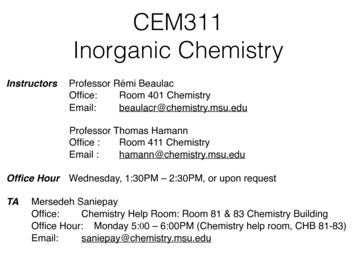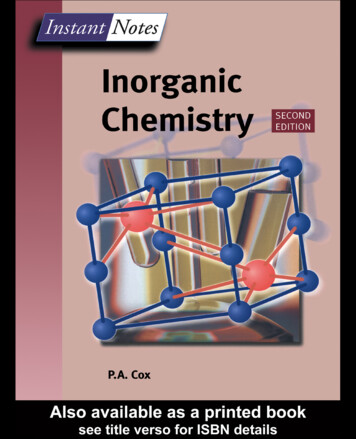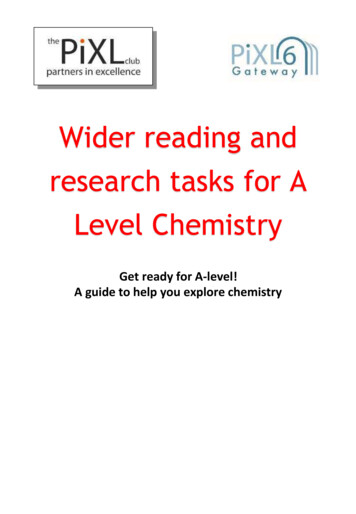
Transcription
CEM311Inorganic ChemistryInstructorsProfessor Rémi BeaulacOffice:Room 401 ChemistryEmail:beaulacr@chemistry.msu.eduProfessor Thomas HamannOffice :Room 411 ChemistryEmail :hamann@chemistry.msu.eduOffice Hour Wednesday, 1:30PM – 2:30PM, or upon requestTAMersedeh SaniepayOffice:Chemistry Help Room: Room 81 & 83 Chemistry BuildingOffice Hour: Monday 5:00 – 6:00PM (Chemistry help room, CHB 81-83)Email:saniepay@chemistry.msu.edu
Grading-Quizzes: 10 %. Distributed periodically, gradedgenerously.-Homeworks: 15%. Distributed weekly.-3 Midterms: 50% total-1 Final: 25%The following grading scheme will be used:4.0 for 90%,3.5 for 80%,3.0 for 70%,2.5 for 60%,2.0 for 50%,1.5 for 40%,1.0 for 30%,0.5 for 20%0 for 20%Note that these percentages represent the maximum needed for a given gradeand I am generous when it comes time to assigning a final grade.
Format of the ClassHomeworkThere will be homework problems assigned weekly to help reinforce information presented in thelectures and the textbook. Homeworks need to be turned in by the beginning of the class indicatedon the header of the homework in order for full credits to be given. Late homeworks will be gradedwith a 50% penalty. All completed homework need to be turned in to pass the class, no matter thegrade.QuizzesQuizzes will be distributed periodically – these quizzes are intended to be short ( 5 to 10 minutes),and will be designed to help you stay on track with the new material covered in class. Most of thetime, these quizzes will be given at the end of one class and due at the beginning of the other, butin-class quizzes might also be distributed. In general, quizzes will be graded very generously – theidea is to encourage you to at least give it a try; nevertheless, missed or late quizzes will not begraded.MidtermsThere will be three midterm exams; each are cumulative, but with a large emphasis on the morerecent materials covered before each exam. The midterms will be given outside regular class timeto allow for extended exam time. No make-up midterm exams will be given. In the event ofillness or other extenuating circumstance, you must notify the instructors prior to the examination.Appropriate documentation will be required, and you will be assigned a score based upon theweighted average score of your other examinations and of your final exam. Only one mid-termexam may be missed—if a second exam is missed the grade on that exam will be zero.On the day of each exam, the class will be replaced by a recitation to review the materials of each exam.
Format of the ClassFinal ExamThe final exam is scheduled for Thursday, May 5, 12:45PM – 2:45PM in Chemistry 136. Students whohave more than two final exams scheduled for the same day will be allowed to take an alternate exam.If you have a conflict with the exam times, please contact the instructors immediately.Exam ScheduleMidterm 1: Wednesday, February 10, 7 - 9PM, Chemistry 136Midterm 2: Wednesday, March 16, 7 - 9PM, Chemistry 136Midterm 3: Wednesday, April 13, 7 - 9PM, Chemistry 136Final Exam: Thursday, May 5, 12:45PM - 2:45PM, Chemistry 136
Tentative Sequence of TopicsBlock 1Week 1 - 2Atoms &Diatomic MoleculesBlock 2Week 3 - 4Chemical Bondsin MoleculesBlock 3Week 5 - 7SymmetryBlock 4Week 7 - 10Inorganic Complexes& Ligand-Field TheoryBlock 5Week 11 - 12Solid-State MaterialsBlock 6Week 13 - 16Special Topics
What is InorganicChemistry?Inorganic chemistry is the study of the synthesis andbehavior of inorganic and organometallic compounds. It hasapplications in every aspect of the chemical industry–including catalysis,materials science, pigments, surfactants, coatings, medicine, fuel, andagriculture. Inorganic chemists are employed in fields as diverse as the miningand microchip industries, environmental science, and education. Their work isbased on understanding the behavior and the analogues for inorganicelements, and how these materials can be modified, separated or used–oftenin product applications. [.] Inorganic chemists compare their jobs to those ofmaterials scientists and physicists. All three fields explore the relationshipbetween physical properties and functions, but inorganic chemistry is themost keenly focused on these properties at the molecular level.American Chemical Society, Careers in Chemistry
Inorganic CompoundsDisplays are Everywhere!ElectronicsLightingEnergy ConversionEnergy StorageLasersPolymerization Catalysts
Organic Compounds.
vs Inorganic Compounds.
Characteristics ofInorganic Compounds d and f orbitals are populated, or easily accessiblevery weak to very strong bondswide variety of geometriescan have unpaired electrons (magnetism)Low-energy electron excitationsMany stable oxidation states
Medicinal ChemistrycisplatinMSU 1965Prof. BarnettRosenberg1926-2009MSU: 1961-1997
Organometallic CatalysisOlefin Metathesis ReactionRobert GrubbsNobel 2005MSU 1969-1978Caltech 1978-
Artificial Photosynthesis 1980s2011Harry B. GrayDaniel G. NoceraColumbia 1961-1966Caltech 1966-MSU 1984-1997MIT 1997-2013Harvard 2013-
Bioinorganic ChemistryHemoglobinPhotosystem IIstructure of the OEC(oxygen-evolvingcomplex)as of 2015
NanotechnologiesCarbon Nanotubes New electronic devices Energy-efficient light-emission Bio-imaging Targeted drug deliveryQuantum Dots1-100 nanometers1 nm 10-9 m
It All Starts with the Atom Table 1.1 - Properties of the Proton, Electron, and NeutronRuS8Mass spectrometric traces for (a) atomic Ru and (b) molecular S8; themass : charge ratio is m/z and in these traces z 1. (c) The molecular structure ofS8.Figure 1.1
Niels Bohr (1885 - 1962)The atom is:1) Negatively charged particles(electrons) orbiting around2) a positively charged and heavynucleus3) on circular orbits of very preciseradii.The Rutherford-Bohr Atom:An electron can change its orbit byabsorbing or releasing energy underthe form of light
Problems with the Bohr Model:Why is the electron not falling onto the nucleus? Whatmakes it “stay” on precise orbits?The Bohr model only works for atoms with one electron,that is, it only works in practice for hydrogen The Bohr model says nothing about molecules, whichmeans that it is not very useful for chemists.
Email: beaulacr@chemistry.msu.edu Professor Thomas Hamann Office : Room 411 Chemistry Email : hamann@chemistry.msu.edu Office Hour Wednesday, 1:30PM - 2:30PM, or upon request TA Mersedeh Saniepay Office: Chemistry Help Room: Room 81 & 83 Chemistry Building Office Hour: Monday 5:00 - 6:00PM (Chemistry help room, CHB 81-83)










